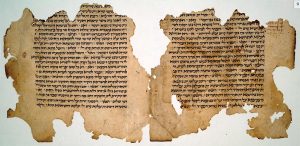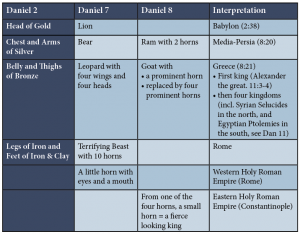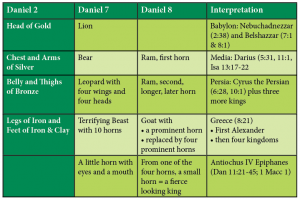True Principles & Uncertain Details About Prophecy, Part 1
This series will separate between first principles and uncertain details for prophetic interpretations.
 Read Time: 8 minutes
Read Time: 8 minutes
We introduced our new First Principles section in June, 2020, and indicated that it would include four overlapping kinds of material. Since then, we’ve had a series of articles on “Jesus: God with us” and one on “The Parable of the Rich Man and Lazarus.” These were examples of the first two kinds: (a) “This is a faithful saying” articles that support true doctrines and (b) “Another gospel” articles that refute false doctrines.
If we insist that others agree with us on these secondary, more uncertain areas, then we’ve gone too far.
This month we start a new series on prophetic interpretations that includes some aspects of (a) and (b), but is more centered on the other two kinds: (c) “Let everyone be persuaded in their own mind” articles that discuss “uncertain details” which are not in our statement of faith and should not be tests of fellowship and (d) “Be merciful to those who doubt” articles that encourage dialog on things we are uncertain about.
If we insist that others agree with us on these secondary, more uncertain areas, then we’ve gone too far. Near the end of his life, Bro. Roberts wrote an article entitled “True Principles and Uncertain Details: Or the Danger of Going Too Far in Our Demands on Fellow-Believers,” published in The Christadelphian magazine in May, 1898.1 Among other things, he said,
“It is possible to go too far in our demands on fellow-believers. How far we ought to go and where to stop, is at one time or other a perplexing problem to most earnest minds. They are afraid on the one hand of compromising the truth in fellowship; and on the other, of sinning against the weaker members of the body of Christ. The only end there can be to this embarrassment is found in the discrimination between true principles and uncertain details that do not overthrow them.”
This series will separate between first principles and uncertain details for prophetic interpretations. I’ll do this by going through the Birmingham Amended Statement of Faith, Clauses 17-30, which are about the Kingdom of God and related topics. For each group of clauses, I’ll quote the truth we receive, any contrasting doctrines that we reject, and any relevant comments Bro. Roberts already wrote on the topic in his article. Then I’ll make some additional comments emphasizing uncertain details about which we are free to have different opinions.
THE KINGDOM OF GOD ON THE EARTH
We all agree with these statements:
BASF2 Clause #17—That the Gospel consists of “The things concerning the Kingdom of God and the Name of Jesus Christ.”3
BASF Clause #18—That the “Things of the Kingdom of God” are the facts testified concerning the Kingdom of God in the writings of the prophets and apostles, and definable as in the next 12 paragraphs.
BASF Clause #19—That God will set up a Kingdom in the earth, which will overthrow all others, and change them into “the kingdoms of our Lord and His Christ.” 4
Doctrines to be Rejected # 12—That the Kingdom of God is “the church.”
Believing them is essential to our salvation. They are so important and so well-attested in Scripture that we make them tests of fellowship. Candidates for baptism must believe them and we insist our brothers and sisters believe them to share the emblems with us.
We preach them in our public proclamation of the gospel and we teach them in our Sunday schools and first principle classes. These principles are so fundamental to the gospel message that we find allusions to them in dozens or even hundreds of Bible passages; among others, the BASF cites two in Daniel (2:44; 7:13-14) and one in Revelation (11:15). These are among the few passages from these two books that we cite in our statement of faith.
In particular, the BASF doesn’t refer to Nebuchadnezzar’s metallic image of a man in Daniel 2, or the beasts that came up out of the sea in Daniel 7, or the ram and the goat in Daniel 8. As much as we love our interpretations of these chapters, and as sure as we are that we have them figured out, we have all willingly agreed that they are not essential. So, we should not treat them as tests of fellowship.
This assertion may challenge some of us. The crucial point is that we need to be flexible on these details. Although many of us think we know for sure the correct interpretation of the four kingdoms that precede the Kingdom of God, we may not have it right. That’s OK. These specifics are not essential and acting like they are can cause serious problems.
DANIEL’S FOUR KINGDOMS
In the case of Daniel’s four kingdoms, this issue of alternative interpretations may not be as hypothetical as you think. Diligent Bible students have proposed at least two legitimate interpretations. Both of them have good Scriptural support and both have unresolved issues that are difficult to explain. The surprising thing is that most Christadelphians are only familiar with one of them.
The two tables at the end of this article illustrate the two approaches, which are referred to as the Roman Scheme and the Grecian Scheme. The two interpretations differ in their identifications of the four kingdoms. The Roman Scheme interprets them to be: Babylon, MediaPersia, Greece, and Rome; this is the standard Christadelphian approach.5 The Grecian Scheme interprets the four kingdoms to be: Babylon, Media, Persia, and Greece; this approach can be found in many commentaries on the book of Daniel.6
THE GRECIAN SCHEME WAS EARLY
Besides the internal evidence for the Grecian Scheme in Daniel and other Old Testament references there is external evidence that this interpretation was probably earlier than the Roman Scheme. For example, there are interpretative glosses in the Syriac translation Peshitta-Daniel manuscripts.
These are like modern section headings in our Bibles that are intended to guide the reader to the proper identification of the kingdoms. The glosses in Daniel 7 correspond to the Grecian Scheme: “And four great beasts arose from the sea, and were different, each from the other.
The Kingdom of the Babylonians: The first was like a lion…
The Kingdom of the Medes: And the second beast was like a wolf*…
The Kingdom of the Persians: After these I was seeing another beast like a leopard…
The Kingdom of the Greeks: After these things I was seeing… the fourth beast… And I was considering its horns (Antiochus Epiphanes) and one small horn came up from between them… Antiochus: I was seeing this horn made war with the Holy Ones.” (Dan 7:3-8, 28, Peshitta).7
Bauscher adds the following footnote: “Both ‘bear’ and ‘wolf ’ are identical in Aramaic. Vowel points are different for each, but the original were written without vowel points.” Then he quotes Professor Marcus Jastrow, A Dictionary of the Targumim: “deb (wolf) was her (Media’s) name (with ref. to Jer 5:6).”
THE ROMAN SCHEME WAS NEW
In addition, the Apocryphal book of 2 Esdras, chapters 11-12, has an updated vision of Daniel’s fourth beast as “an eagle that had twelve feathered wings and three heads” (2 Esdras 11:1 NRSV). After describing the vision, the writer shares the interpretation given to him:
“And twelve kings shall reign in it, one after another. But the second that is to reign shall hold sway for a longer time than any other one of the twelve… In the midst of the time of that kingdom great struggles shall arise, and it shall be in danger of falling; nevertheless it shall not fall then, but shall regain its former power… As for your seeing three heads at rest, this is the interpretation: In its last days the Most High will raise up three kings, and they shall renew many things in it, and shall rule the earth and its inhabitants more oppressively than all who were before them… As for your seeing that the large head disappeared, one of the kings shall die in his bed.” (2 Esdras 12:14-15, 18, 22-24, 26 NRSV).
Theodore A. Bergren, contributor on 2 Esdras in The New Oxford Annotated Bible, New Revised Standard Version with The Apocrypha, Fourth Edition, outlines how the elements of the vision relate to the Roman Empire (pp. 1703- 1706):
- “11:1 – An eagle, symbol of the Roman Empire, used on the standards of Roman legions
- 12:14 – Kings, the Roman emperors • 12:15 – The second king is Augustus (ruled 27 BC – 14 AD)
- 12:18 – great struggles for power that followed the death of Nero in 68 AD • 12:22 – Three heads, the Flavian emperors (Vespasian, 69-72 AD; Titus, 79-81; and Domitian, 81-96)
- 12:26 – The large head, Vespasian. Vespasian did die in his bed.”
But the writer of 2 Esdras makes it plain that his interpretation is different than the original one in Daniel, and so implicitly endorses the Grecian Scheme by saying the Roman Scheme is new:
“He said to me, ‘This is the interpretation of this vision that you have seen: The eagle that you saw coming up from the sea is the fourth kingdom that appeared in a vision to your brother Daniel. But it was not explained to him as I now explain to you or have explained it.’” (2 Esdras 12:10-12 NRSV).

Targum Onkelos, Leviticus 4:10-8 / Aramaic script
THE APOCALYPTIC METHOD
In the same way, the inspired New Testament writers re-apply Daniel’s allusions to Antiochus Epiphanes and (a composition of) the four kingdoms by re-interpreting them in terms of Rome’s destruction of the temple in Jerusalem (2 Thess 2; Mark 13; Rev 13). This is how apocalyptic literature works. D. S. Russell describes the basic apocalyptic process:
“Their [apocalyptic writers’] method was to fasten on predictions made in the past which had not been fulfilled in the literal sense of the passages concerned and to see in them hidden and symbolic meanings which they would proceed to recast and re-interpret. By thus reinterpreting and re-applying the message of prophecy to succeeding generations they showed it to be not only a ‘forth-telling’ but a ‘foretelling’ of the word of God. For this reason apocalyptic has sometimes been described as ‘unfulfilled prophecy,’ and to a large extent this is true.
An example of this is to be found in Jeremiah’s prediction of seventy years’ captivity before the final restoration (Jer 25:11; 29:10) which is interpreted by the writer of Daniel as seventy weeks of years (9:24)… Another example is the prophecy recorded in Daniel 7:23. There the fourth beast obviously represents Greece, but in 2 Esdras 12:11 it is given an entirely new interpretation and now represents Rome.” (Between the Testaments, first paperback edition, 1968, pp. 103-104).
Similarly, H. H. Rowley explains: “Yet some analysis is necessary to the understanding of apocalyptic. For it is essentially the re-adaptation of the ideas and aspirations of earlier days to a new situation” (The Relevance of Apocalyptic, 1946, p. 13).
CONCLUSION
Both of these approaches to Daniel 2, 7, and 8 have some merit. Thankfully, our forefathers had the wisdom not to make any one approach mandatory to be a Christadelphian. As a result, we have the freedom to discuss these options, and others, openly and without fear. This flexibility on these details contrasts with our insistence on the first principle that God will set up His Kingdom in the earth.
Joe Hill
Austin, Leander, TX
***
The following two interpretations differ in their identifications of the four kingdoms. The Roman Scheme interprets them to be: Babylon, MediaPersia, Greece, and Rome; this is the standard Christadelphian approach.5 The Grecian Scheme interprets the four kingdoms to be: Babylon, Media, Persia, and Greece; this approach can be found in many commentaries on the book of Daniel.6
Roman Scheme:

Grecian Scheme:

***
Footnotes:
1 Available online at www.angelfire.com/bc2/Bereans/Cornerstones/Fellowship/true_principles.html
2 BASF is short for the Birmingham Amended Statement of Faith (BASF), which summarizes the first principles of the one faith in the Bible that are essential for salvation.
3 Acts 8:12; 19:8, 10, 20; 28:30-31.
4 Dan 2:44; 7:13-14; Rev 11:15; Isa 32:1, 16; 2:3-4; 11:9-10.
5 See, for example, John Thomas, The Exposition of Daniel, 1868.
6 See, for example, William B. Nelson, Daniel, Understanding the Bible Commentary Series, Baker Books: 2012; and H. H. Rowley, Darius the Mede and the Four World Empires in the Book of Daniel, Wipf & Stock: republished 8/24/2006 (originally published in 1964).
7 Glenn David Bauscher, The First Century Aramaic Bible in Plain English – The Major Prophets (Isaiah to Daniel), 2015, p. 187. See also, Richard A. Taylor, “The Book of Daniel in the Bible of Edessa,” Aramaic Studies 5.2 (2007), pp. 250-251.